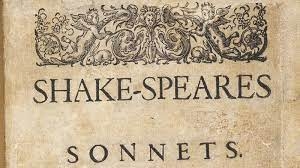
Shakespeare’s sonnet sequence is comprised of 154 sonnets that were published in 1609. The vast majority of these sonnets are addressed to an unnamed attractive young man who represents beauty, love, and praise. In these sonnets, Shakespeare is reiterating to the young man that it is his duty to marry and have kids, urging him to reproduce so that his physical beauty will be eternalized through future generations.
Shakespeare’s sonnets are composed of 14 lines, each written in iambic pentameter and most with the traditional rhyme scheme of the English sonnet: abab cdcd efef gg. In addition, Shakespeare’s sonnets typically have three distinct quatrains, each of which often is constructed with a separate metaphor and a closing couplet that ties everything together.
As for the larger structure of the sonnet sequence, it is important to note that, as Shakespeare provided no explanation for the intentions behind his sonnets, the order in which he intended them to appear is unknown. Therefore, the order in which they were published might not have been the order in which Shakespeare had written them.
Shakespeare uses many nature-oriented metaphors in his sonnets. It is noteworthy to point out that Shakespeare is never afraid to portray nature in a distasteful manner.
Various themes exist in Shakespeare’s sonnet sequence. First of all, love is seen as a common theme, as it was in many of the Elizabethan sonnets. In addition, Shakespeare’s sonnets focus on the power of time, and how time can wither away beauty. In many of his poems that are written to the young man, Shakespeare (the narrator) is demonstrating the theme of the importance of reproduction. He asserts the value of eternalizing beauty through reproduction and by passing it down through generations. His sonnets focus on physical beauty rather than intellectual beauty. Regarding the theme of time, Shakespeare asserts that only love and poetry (or another type of writing) are the only phenomena that can counter time.
Credit : British Literature
Picture Credit : Google




